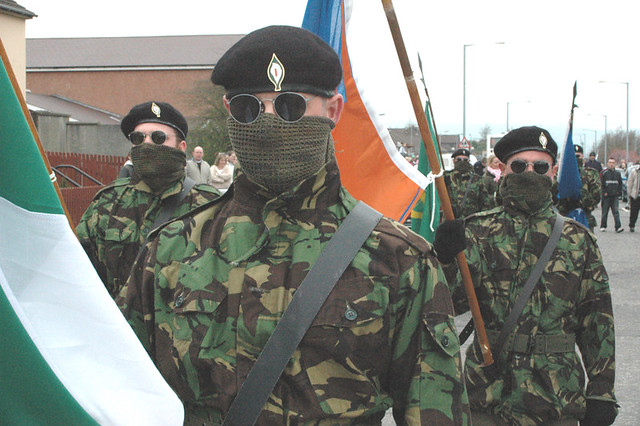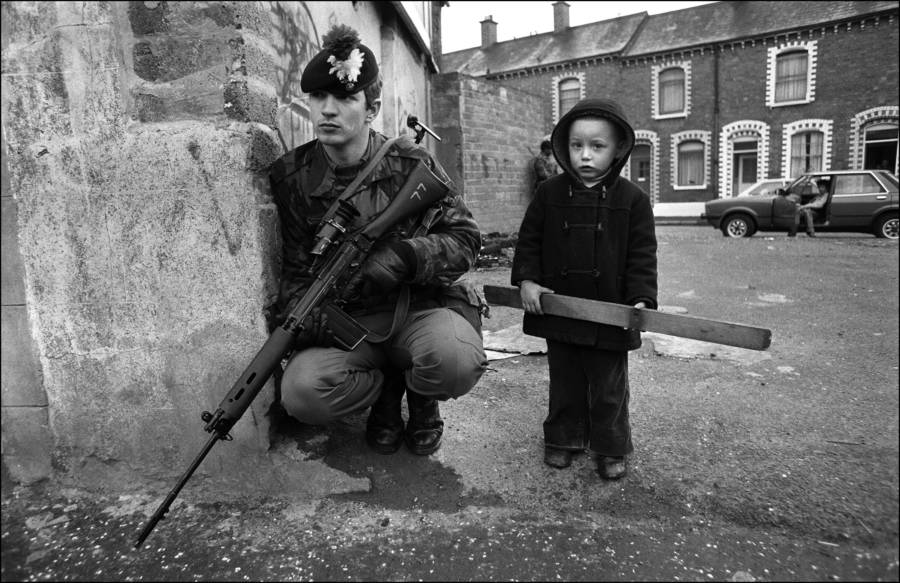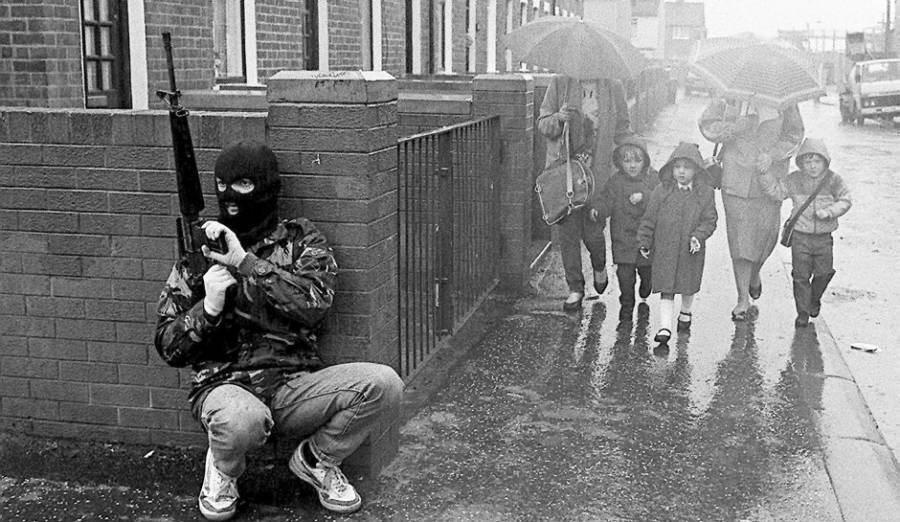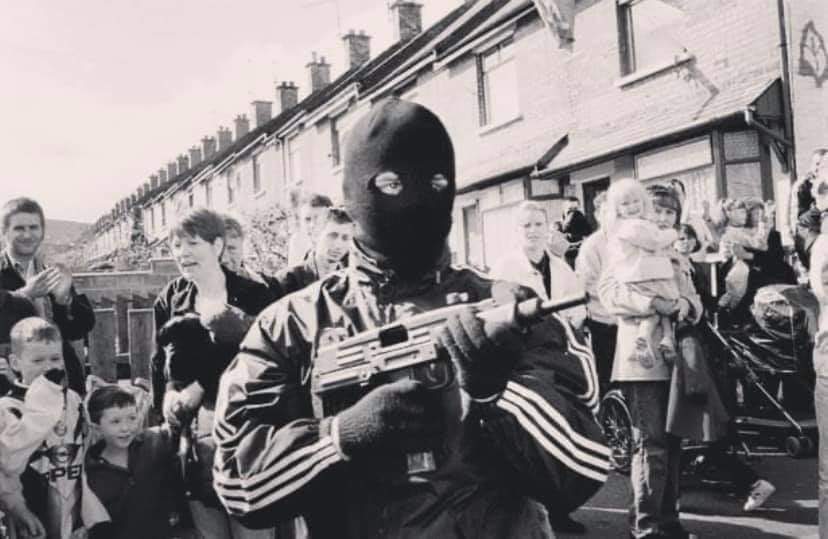Disclaimer – Reaper Feed does not condone or support any of the political views or actions of the various paramilitary groups active in the conflict in Northern Ireland. We made this trip in order to gain an insight into the horrific days of The Troubles through the people who lived it, on both sides of the political spectrum.
The team at Reaper Feed is far from being ‘Armchair Generals’ and throughout the year we actively set out to cover conflict zones around the world. As global travel has slowed to a halt we’re counting the lucky stars that we managed to get a handful of adventures in this year before things were locked down. In late 2019, we were contacted by a charity that focuses on providing insights into the war in Northern Ireland by employing former paramilitary combatants as guides in the toughest areas of Belfast.
We were offered a dual narrative tour that explores both the Nationalist and Loyalist strongholds of Belfast in order to write an article on the Northern Ireland conflict today. As the troubles have simmered down since the early noughties, one of our office team asked ”is the ira still active?”, this question was answered the next day as a journalist was shot in the head during a riot in the IRA stronghold of Derry. Soon after, our bags were soon packed and the Reaper Feed team was on our way to meet the IRA and the UDA militants in Ireland.

The plan of action was to first meet a former commander of the IRA (Irish Republican Army) who would then escort us around the Nationalist Falls Road area of Belfast, explaining the conflict and their frontline experience and take us into some of the most infamous pubs in the area. He would then take us to the so-called ‘peace wall’ where we would be handed over to a former commander of the UDF (Ulster Defence Force) who would be our guide for the Loyalist area of the Shankill Road.
The Troubles Summary
Firstly, we’ll give you a brief Northern Ireland conflict summary in true Reaper Feed style. The Troubles erupted during the late 1960s and were primarily political and nationalistic and propelled by centuries of blood-soaked history between Irish and the English. The conflict in Ireland had an ethnic or sectarian dimension and raged for almost thirty years until the Good Friday Agreement in 1998 and became the longest operation ever undertaken by the British Army.
Throughout the conflict, extreme violence took place in both Ireland, England, and Europe. The Troubles were fought between Irish Republicans like the IRA who wanted a united Ireland and for Northern Ireland the leave the UK, the British Army and loyalist paramilitaries like the UDA who wanted Northern Ireland to remain British. The Irish Republicans were largely catholic whereas the Loyalists were mostly protestant.
“Who should be held accountable for a shared history of violence? It was a question that was dogging Northern Ireland as a whole.â€
– Patrick Radden Keefe
Throughout the Troubles in Ireland, Republican militant groups like the IRA waged a guerrilla war against the British Army and Loyalist paramilitaries via bombing campaigns, shooting attacks, kidnappings, and other forms of terror. Loyalist militant groups like the UDA launched similar attacks against Republican militants as well as the general Catholic community in Belfast. The British security forces waged a hard-fought counter-insurgency war mostly against the IRA. As well as violent warfare, The Troubles also spawned various riots, mass protests, and acts of civil disobedience which collectively led to extreme levels of segregation and the formation of no-go areas for Catholics and Protestants alike.

It’s shocking how many people died during The Troubles. By the signing of the Good Friday Peace Agreement, there were over 3,500 deaths in The Troubles in Belfast (mostly civilians). In the years since there has still been sporadic violence and killings but nothing comparable to the height of the Northern Ireland conflict.
We couldn’t get a direct flight to Belfast so we flew to the adjacent city of Liverpool and boarded the night ferry over the Irish Sea to Belfast, an adventure in itself. The Irish Sea is not for the faint-hearted and a stormy winters night meant we got little sleep. On arrival into Belfast, we set ourselves up for the day with a classic Ulster breakfast which is essentially a full English breakfast but on steroids.

Our meeting point with the IRA was at a place called Divis Flats at 10:00 am and we had a few hours to spare so we took the chance to explore the center of Belfast which is a truly stunning city with some epic architecture and even has a Lenin statue! Whilst many may assume that the most infamous areas of Belfast and located far from the downtown area, they may be surprised to find they are only around a 5-10 minute walk from the city center.
As we approached the rendevous point we noticed that the Victorian era grandeur of downtown had now faded into 1970s Brutalist architecture. We were soon at the entrance of the Falls Road which is marked with an enormous sign warning police, British Army, and MI5 operatives to stay away. As we waited, 10:00 am came and went. The IRA was late. Taking in our surroundings we noticed a plaque on the wall behind us commemorating two people who had been murdered by the Royal Ulster Constabulary (RUC) on the spot we were standing.

We clearly stood out as strangers and attracted a few suspicious glances from passing cars. Suddenly, we spotted a guy coming towards us with the type of swagger and battle-hardened eyes that only a paramilitary commander has. Dressed in a combination of smart dress shoes and an expensive Stone Island parka, he introduced himself as “Tony” and started to lead us into the Falls Road.
Now in his mid-60s, Tony was a down to earth character who pulled no punches. During the height of what he called his ‘active service’ with the IRA during the 1980s, Tony commanded a team of IRA militants and took part in a series of IRA attacks on both the British security forces as well as Loyalist paramilitary groups. Naturally, we assumed he wasn’t keen on his photo being taken and we didn’t ask.

By the early 1990s, Tony was arrested alongside many other Provisional IRA members on charges of terrorism and bomb-making and received a life sentence in the infamous H Block prison. However, during the Good Friday Peace Agreement in 1999, Tony was released alongside thousands of other extremely dangerous men. Throughout our journey through Belfast’s Nationalist Areas with Tony, he was often interrupted by passers-by waving at him from cars or stopping to shake his hand. His respect in this area was obvious from the start.
Tony’s tour of his area including the infamous murals that define both lines of the troubles in Northern Ireland. From those threatening eternal armed struggle at home and abroad to threatening images of armed men promising a death sentence to any drug dealers caught in the area, all are distinctly unique. Alongside the murals are a series of more crude graffiti that symbolize local views from ‘Up the IRA’ scrawled on walls to ‘death to the Huns’ stickers on trash cans.

The tour was interjected with various IRA stories told from Tony’s first-hand experience during the worst years of the conflict as well as his criticism of the new IRA comprised of impressionable youth who are eager to dish out senseless violence in the name of their view Irish Republicanism.
At the Irish Republican museum, we met more former prisoners who provided us with an in-depth lesson on Irish Republican history as well as IRA weapons and tactics. We checked out the various weapons used during the height of the conflict. The Provisional Irish Republican Army was armed with a lethal array of weapons, from Armalite assault rifles to anti-aircraft systems, many of their arsenals were supplied by Qaddafi’s Libya and sympathizers in the USA. The museum also had an array of artifacts from the 1916 uprising in Dublin as well as a wall adorned with a giant IRA flag made by IRA members who had been incarcerated.

The next destination on our tour was a long walk, so Tony flagged down a black Hackney cab which we soon learned had a dark history of their own during the troubles. Throughout the conflict in Northern Ireland, public buses that entered the Falls Road were often hijacked and burnt out to be used as barricades which made it extremely difficult for people in West Belfast to get to work. To combat this, black taxis from England appeared, and under IRA control they began their own public transport system. Despite being a safer way to travel during the troubles, the infamous Loyalist gang “The Shankhill Butchers” utilized this sense of security and used black cabs to lure and kidnap Catholics at random, eventually brutally murdering 23 people.
We soon arrived at our next stop, the Milltown Cemetery, which was the resting place of various IRA volunteers including Bobby Sands. Whilst graveyards are usually considered peaceful places, during the troubles the Milltown graveyard was far from it. On the 16th March 1988, Milltown Cemetery was the host of the enormous funeral held for these three IRA members killed by British Special Forces in Gibraltar. As thousands of mourners gathered to pay their respects, a number of hand grenades were thrown into the crowd by a UDA paramilitary named Michael Stone. All of it was captured on camera.
As most mourners took cover, IRA militants in the crowd moved between gravestones to capture Stone, who was armed with a handgun and firing off shots as he attempted to flee the scene. Stone was captured by the IRA and almost beaten to death before being rescued by security forces and police. In the aftermath of the attack, 3 people lay dead and 60 were seriously wounded.
A few days later during the funeral of one of the victims of the Milltown attack, two British Army soldiers drove into the vicinity of the mourners. Despite not being in uniform, they were identified as security forces by local IRA who surrounded their car to capture them. The scene was captured from a British helicopter hovering overhead as the men released pistol rounds through the roof to deter the attackers. They were soon overrun, dragged from their vehicles and beaten to within an inch of their lives before being stripped naked and shot in the head. ‘They were some of the darkest days of the troubles’ said Tony.
‘You’ll love this place, it does a lovely pint of black. It’s always been a popular spot with IRA members which made it a target in the past. Loyalist cunts fired a fuckin’ RPG at it in ’94.’
– Tony
We’d been walking for a few hours at this point when Tony turned around and said ‘are yous fancying a pint?’, as it happened, we were. Tony said he knew a good place just down the road that we’d like. Tony led the way as he swaggered down the street before half turning his head to say ‘You’ll love The Rock, it does a lovely pint of black. It’s always been a popular spot with IRA members which made it a target in the past. Loyalist cunts fired a fuckin’ RPG at it in ’94.’

Tony wasn’t exaggerating. As we reached the pub we saw a body of text on the wall underneath a large Irish Republican Flag flying in the wind: ‘The Rock survived 2 world wars and multiple attacks over the years including an RPG attack during the troubles in 1994’. As we went to enter, Tony answered a call on his mobile and gestured for us to go on ahead and he’d follow us. Looking back, I think this was a test of nerve to see if we had the balls to go in alone. As we walked through the doors it was like a stereotypical scene from a movie as almost every head turned to give us a suspicious glare.
Throughout the troubles, bars in Belfast were deadly places and subject to relentless bombings and machine-gun attacks. Things have improved but the suspicions still remain. ‘Yous lost are yous?’ said the barman half-jokingly as we approached the bar. ‘No, our mate told us about this place, he’s just taking a call outside’ I replied. ‘3 of the black then, is it?’ said the barmen with a suspicious look still persistent in his eyes. Like many on the Falls Road, he was only in his 20s but had eyes that looked a lot older. We didn’t take photos inside the bar, but here’s a video filmed inside during one of their famous ‘Rebel Sundays’.
In classic Irish custom, the Guinness was poured but withheld to allow it to settle before being handed over. We took out pints over the old wooden planked floor to the stained glass, Victorian-era booths that looked like something from Peaky Blinders. One could only imagine what must have been discussed in this discreet booths during the troubles.
After a few minutes Tony burst through the door and received a warm welcome from the locals. ‘Here! Get these lads some food served up will yous?’ he shouted in his characteristic Belfast accent before sitting down with us. ‘Christ, if these walls could talk lads’. Tony was in prison when the infamous attack was launched on the Rock Bar in ’94, but his brother war present. As the pub was packed on a winters evening, Loyalist Paramilitaries under the command of Johnny ‘Mad Dog’ Adair launched a rocket-propelled grenade from the street opposite. The rocket was poorly aimed and smashed through the upstairs window without killing anybody. Many other bars weren’t so lucky.

After a few pints, we walked down RPG avenue before turning onto a street that straddled the infamous peace wall. As we reached the final point of this half of the tour, Tony diverted to show us a hard-hitting sight. The homes situated right behind the wall were covered with an enormous steel cage, inside which children were playing happily. The cage serves as a form of protection against petrol bombs and other deadly missiles launched over the wall. Tony was quick to point out that houses on the Loyalist side of the wall are also forced to protect their kids in the same way.

As we reached the gate that marks the end of the nationalist territory of the Falls Road, the scene in front of us was simply depressing as we gazed down the long road between two enormous razor wire and cage covered walls determined to quell sectarian violence. We thanked Tony for his time and efforts during the day. This former member of the Irish republican army explained the conflict in a way few people could. After a few minutes, a hulking figure was slowly walking our way. It was the UDA commander who would be our escort along the infamous Shankill Road, the stronghold of Belfast’s Loyalist paramilitary forces. Tony’s face greeted him with a stony gaze. Stay tuned for part 2.













